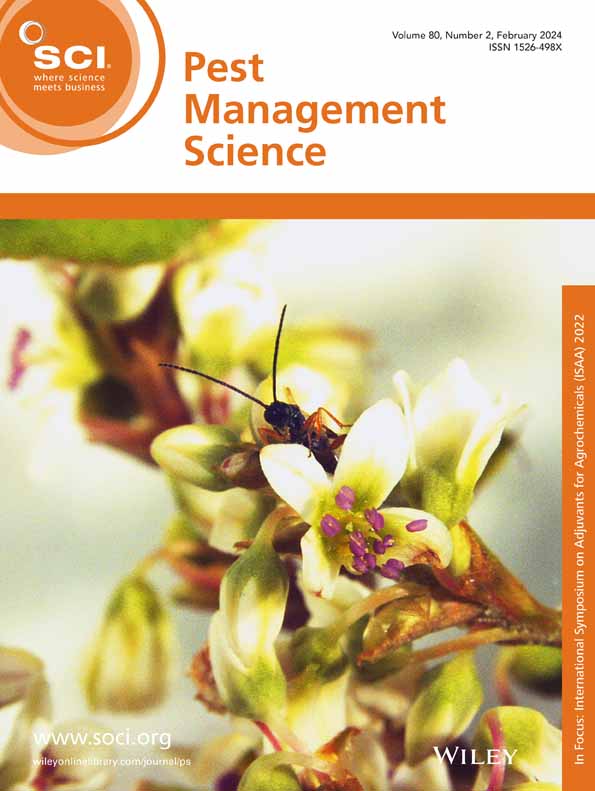Volatile organic compounds released from cabbage plants infested with wingless green peach aphid (Myzus persicae) attracts more conspecifics.
IF 3.8
1区 农林科学
Q1 AGRONOMY
引用次数: 0
Abstract
BACKGROUND Plants release a diverse array of volatile organic compounds (VOCs) that play a role in interactions with other plants and arthropod herbivores. The potential of using plants that emit either repellent or attractive VOCs to help managing insect populations have been shown. However, the response of the green peach aphid (Myzus persicae), a major sucking insect pest worldwide, to VOCs from cabbage and infested with conspecific remains unknown. This study investigated how VOCs released by cabbage infested or uninfested by Myzus persicae influenced host selection in seven different cultivars. and compared under infested and non-infested conditions. RESULTS Using headspace solid-phase microextraction gas chromatography coupled with mass spectrometry (SPME-GC-MS), we identified 22 VOCs from non-infested cabbage plants and 33 from aphid-infested plants across the seven cabbage cultivars. Infested plants emitted a greater diversity and higher amounts of volatiles, dominated by terpenes and green leaf volatiles. Caryophyllene was the only compound common in both infested and non-infested plants. In olfactometer assays, wingless Myzus persicae showed a significant attraction to conspecific-infested plants with the strongest response to the cultivar QG 80. However, this increased attraction was not consistent across all cultivars, highlighting the need for further studies to understand the ecological implications and potential benefits or drawbacks of this attraction. CONCLUSION Our findings highlight the potential of using VOC-emitting trap crops for the targeted management of Myzus persicae. By identifying key volatiles that attract aphids, this study provides a foundation for developing eco-friendly pest control strategies. © 2025 Society of Chemical Industry.被无翅绿桃蚜(Myzus persicae)侵染的白菜植株释放出挥发性有机化合物,吸引更多同种蚜虫。
植物释放出多种挥发性有机化合物(VOCs),这些化合物在与其他植物和节肢动物的相互作用中发挥作用。利用释放令人反感或有吸引力的挥发性有机化合物的植物来帮助管理昆虫种群的潜力已经得到证明。然而,世界上主要的吸血害虫绿桃蚜(Myzus persicae)对白菜中挥发性有机化合物的反应尚不清楚。研究了7个不同品种被桃蚜侵染或未侵染的白菜释放的挥发性有机化合物对寄主选择的影响。并在有虫和无虫的条件下进行比较。结果采用顶空固相微萃取-气相色谱-质谱联用技术(SPME-GC-MS),在7个品种中鉴定出22种挥发性有机化合物(VOCs)和33种挥发性有机化合物(VOCs)。受侵染植物释放的挥发物种类更丰富,含量更高,以萜烯类和绿叶挥发物为主。石竹烯是唯一在侵染植物和非侵染植物中均存在的化合物。嗅觉测定结果表明,无翅桃蚜对同种侵染植物具有显著的吸引力,其中对品种qg80的反应最强。然而,这种增加的吸引力并不是在所有品种中都一致的,这突出表明需要进一步研究以了解这种吸引力的生态影响和潜在的利弊。结论利用vocs诱捕作物对桃蚜进行定向治理具有一定的潜力。通过鉴定吸引蚜虫的关键挥发物,本研究为制定生态友好型害虫防治策略提供了基础。©2025化学工业协会。
本文章由计算机程序翻译,如有差异,请以英文原文为准。
求助全文
约1分钟内获得全文
求助全文
来源期刊

Pest Management Science
农林科学-昆虫学
CiteScore
7.90
自引率
9.80%
发文量
553
审稿时长
4.8 months
期刊介绍:
Pest Management Science is the international journal of research and development in crop protection and pest control. Since its launch in 1970, the journal has become the premier forum for papers on the discovery, application, and impact on the environment of products and strategies designed for pest management.
Published for SCI by John Wiley & Sons Ltd.
 求助内容:
求助内容: 应助结果提醒方式:
应助结果提醒方式:


